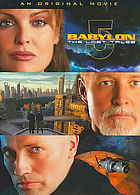
Babylon 5 is an American space opera television series created by writer and producer J. Michael Straczynski, under the Babylonian Productions label, in association with Straczynski's Synthetic Worlds Ltd. and Warner Bros. Domestic Television. After the successful airing of a test pilot movie on February 22, 1993, Babylon 5: The Gathering, Warner Bros. commissioned the series for production in May 1993 as part of its Prime Time Entertainment Network (PTEN). The show premiered in the US on January 26, 1994, and ran for five 22-episode seasons.

Joseph Michael Straczynski is an American filmmaker and comic book writer. He is the founder of Synthetic Worlds Ltd. and Studio JMS and is best known as the creator of the science fiction television series Babylon 5 (1993–1998) and its spinoff Crusade (1999), as well as the series Jeremiah (2002–2004) and Sense8 (2015–2018). He is also the executor of the estate of Harlan Ellison.

GEnie was an online service created by a General Electric business, GEIS, that ran from 1985 through the end of 1999. In 1994, GEnie claimed around 350,000 users. Peak simultaneous usage was around 10,000 users. It was one of the pioneering services in the field, though eventually replaced by the World Wide Web and graphics-based services, most notably AOL.

Crusade is an American spin-off television series from J. Michael Straczynski's Babylon 5, released in 1999. It is set in 2267, five years after the events of Babylon 5, and just after the movie A Call to Arms. The Drakh have released a nanovirus plague on Earth, which will destroy all life on Earth within five years if it is not stopped. The Victory class destroyer Excalibur has been sent out to look for anything that could help the search for a cure.
"Midnight on the Firing Line" is the first episode of the first season of the science fiction television series, Babylon 5, following the pilot movie, "The Gathering". It first aired on January 26, 1994. It was notable for being the first regular television episode which used computer-generated imagery rather than physical models for its special visual effects. The episode also marked the beginning of the first science fiction television series where the entire series had an overarching storyline, which the writer J. Michael Straczynski described as "a novel for television".
"The Parliament of Dreams" is the fifth episode of the first season of the science fiction television series, Babylon 5. The Babylon 5 makeup team won an Emmy Award for the special alien makeup design for this episode.
"The War Prayer" is the seventh episode of the first season of the science fiction television series, Babylon 5. It first aired on 9 March 1994.
"And the Sky Full of Stars" is the eighth episode of the first season of the science fiction television series, Babylon 5. It first aired on 16 March 1994.

Lyta Alexander [1] is a fictional character played by Patricia Tallman in the science fiction television series Babylon 5.

Patricia J. Tallman is an American actress, stunt performer, and studio executive best known for her starring roles in Night of the Living Dead, Star Trek and Babylon 5. She is the former CEO and executive producer of Studio JMS.
James Davis Nicoll is a Canadian freelance game and speculative fiction reviewer, former security guard and role-playing game store owner, and also works as a first reader for the Science Fiction Book Club. As a Usenet personality, Nicoll is known for writing a widely quoted epigram on the English language, as well as for his accounts of suffering a high number of accidents, which he has narrated over the years in Usenet groups like rec.arts.sf.written and rec.arts.sf.fandom. He is now a blogger on Dreamwidth and Facebook, and an occasional columnist on Tor.com. In 2014, he started his website, jamesdavisnicoll.com, dedicated to his book reviews of works old and new; and later added Young People Read Old SFF, where his panel of younger readers read pre-1980 science fiction and fantasy, and Nicoll and his collaborators report on the younger readers' reactions.
rec.arts.sf.tv.babylon5.moderated is a moderated Usenet newsgroup that focuses on the science fiction television series Babylon 5 and the works of writer J. Michael Straczynski. It was spun off from its un-moderated version, rec.arts.sf.tv.babylon5, in 1996. The newsgroup counts Straczynski as a frequent contributor, and was among the first internet-based forums where fans interacted directly with a 'showrunner'.
John E. Hudgens is an independent director, producer, and editor noted for his short Star Wars fan films and for many Babylon 5 promotional videos.

The Lurker's Guide to Babylon 5 is a fan-run website that includes detailed episode guides and analyses, production history notes, background materials, references and other information related to the science fiction epic, Babylon 5. The name is derived from the term lurker, which creator J. Michael Straczynski adopted to refer to the underclass residents on the Babylon 5 station.

Babylon 5: The Lost Tales was intended to be an anthology show set in the Babylon 5 universe. It was announced by J. Michael Straczynski, creator of Babylon 5, at the San Diego Comic Con in July 2006. Straczynski has described the stories as ones he had for the Babylon 5 television series, but never had the time to produce. Only one installment, titled Voices in the Dark, was produced before the project was shelved.
A Usenet personality was a particular kind of Internet celebrity, being an individual who gained a certain level of notoriety from posting on Usenet, a global network of computer users with a vast array of topics for discussion. The platform is usually anonymous, although users can get celebrity status, usually by being deemed different from other posters in some way.
Stellar Occasion was a three-day science fiction convention held in the Dallas, Texas area in the mid to late 1990s. It blended science fiction literary and media guests with space science in an unusual, fan-oriented cross between the traditional science fiction convention and a commercial media event. Stellar Occasion is notable for being an early proponent of the television series Babylon 5 and featuring both writers and actors from the show each year.

Usenet, USENET, or "in full", User's Network, is a worldwide distributed discussion system available on computers. It was developed from the general-purpose Unix-to-Unix Copy (UUCP) dial-up network architecture. Tom Truscott and Jim Ellis conceived the idea in 1979, and it was established in 1980. Users read and post messages to one or more topic categories, known as newsgroups. Usenet resembles a bulletin board system (BBS) in many respects and is the precursor to the Internet forums that have become widely used. Discussions are threaded, as with web forums and BBSs, though posts are stored on the server sequentially.

Babylon 5 is an American space opera media franchise created by writer and producer J. Michael Straczynski, under the Babylonian Productions label in association with Straczynski’s Synthetic Worlds Ltd. and Warner Bros. Domestic Television. After the successful airing of a pilot movie, Warner Bros. commissioned the series as part of the second year schedule of programs provided by its Prime Time Entertainment Network (PTEN). It premiered in the United States on January 26, 1994 and ran for the intended five seasons. Describing it as having "always been conceived as, fundamentally, a five year story, a novel for television", Straczynski wrote 92 of the 110 episodes and served as executive producer, along with Douglas Netter.










